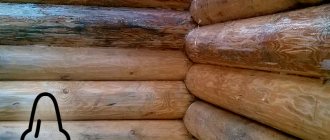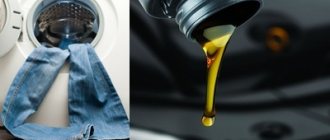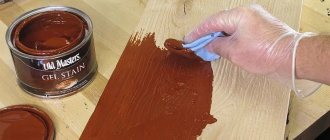A brand new sauna is a pleasure for body and soul. After all, it smells so nice, and the beautiful fresh walls make you feel relaxed. However, in 90% of cases, people face the problem of resin formation on the walls, ceiling and even on the floor. And everyone has a need to eliminate this defect. Before you get rid of resin in a bath using the first method you come across, you need to understand all the existing methods. And use only the safest ones.
Drops of fresh resin on boards in a sauna Source varisilma.fi
Replacing the lower crowns
The lower crowns of the bath structure are subject to strong moisture and climatic factors. As a result, they quickly rot and the building collapses. Therefore, during construction, the lower crowns are made of larch, which only becomes harder from moisture. In another situation, replacement of elements is required. If the crowns are not removed and repaired in a timely manner, the bathhouse will become warped, cracks will form in the walls and the structure will fall apart.
The lower crowns of the bath can be made of larch or oak
Replacement of the lower crowns can be partial or complete. The first option is optimal if only some elements are damaged, for example, in the drainage or slope area. Complete replacement is necessary if the structure is severely damaged. The procedure requires careful organization, and the scope of work is as follows:
- You need to remove all objects and furniture from the bathhouse, remove glass from window frames and doors. If the floor joists are embedded in the lower crown, then the covering is dismantled. The chimney is separated from the ceiling, which will prevent damage to the roof;
- Crowns that do not require replacement are fixed. To do this, about 50 cm are retreated from the corners of the building and 40 mm bars are nailed vertically. The lower ends of the bars are fixed on the crowns of the second level, and the upper ends are nailed to the very last elements;
- Timing of a log house - two logs fastened with a corner joint. We determine which logs will be the top ones in the crown being replaced. The jacks will be fixed under them. You need to retreat 1 m from the corner in the foundation and knock out an opening 40 cm wide. Opposite this opening, you should cut out part of the lower crown log. As a result, the overall height of the niche is sufficient for installing a jack. On two opposite walls, 2 niches are also cut out at the same distance from the corners. The jacks are fixed, and their number is 2–4 pcs. This way you can raise either the entire building or each wall in turn. If you install 4 jacks, the distortion will be less. Using jacks resting on the upper logs of the dressing, you need to raise the frame by 7–10 cm;
- The lower logs are removed and temporary support bars are fixed. The jacks are lowered, the upper logs of the crown being replaced are also lowered and removed. Install new elements and tighten them with jacks. Temporary supports are removed and the following lower elements are replaced. All jacks are lowered simultaneously and the gaps between new and old logs are sealed.
Replacing the lower crowns of a bathhouse requires physical effort. Therefore, structural repairs cannot be carried out alone with your own hands.
Repairing a bathhouse requires good preparation
Leveling: do-it-yourself repairs
Wooden structures are distinguished by the fact that they require correct installation, taking into account the characteristics of the wood. When building a bathhouse, simple rules are not always followed, which leads to deformation of the surfaces and the structure as a whole.
Bulging of the lining
Incorrect installation, high initial moisture content of the wood, accumulation of moisture behind the lining, and improper use of the bathhouse lead to swelling of the lining from which the inner lining is made. Insufficient ventilation leads to the same result.
To avoid deformation, it is important to follow the rules
To eliminate irregularities, the following work is carried out:
- Removing uneven elements and ordinary parts located next to them;
- You need to make sure that the walls are insulated correctly. Otherwise, complete installation of hydro- and vapor barrier is required;
- Installation of the lining is carried out carefully, using the tenon-to-groove method.
The joining of the lining should not be tight, since wood expands when exposed to moisture. It is also worth providing a ventilation gap between the sheathing and the wall insulation.
Correction of a log house
Long-term operation, improper installation of the log house on the ground, high humidity, and ground movement lead to distortion of the structure. Often the building is slanted on only one side, which allows you to correct the situation.
Curvature of a log house is possible for various reasons.
The technology for leveling a bathhouse frame is similar to the technique for replacing the lower crowns. In doing so, follow the following rules:
- installation of at least 2 jacks;
- lightening the building, that is, removing furniture and other items from the inside;
- jacks are raised gradually;
- at one time the lifting height should not exceed 5 cm;
- under the rickety crowns you need to put a new support and boards.
The method of leveling a log house depends on the type of foundation on which the bathhouse is installed. In any case, the structure is leveled or tightened with metal corners.
How to remove resin in a steam room
Steam room in the bathhouse, incl. shelves, built from coniferous wood and resin exudes from the boards. How can you fix such a bathhouse? What can be done? Resin usually comes out of knots, which is where you have to dance))). If it is possible to replace shelf boards with knots with boards without knots, then try to do this, otherwise sitting on such a shelf will be quite uncomfortable and nothing else has been invented yet. The resin will flow out for a very long time. As for the walls, I won’t suggest changing them, it would be very troublesome. You can try to drill out the knots from which the resin is flowing with a feather drill and hammer a chip into this place and sand it. I think the problem will be solved.
I sympathize, I am familiar with this problem and this problem will last for a long time. The resin will be released, depending on the thickness of the boards, for a long time, several years. If it is not possible to change the casing, then get ready for righteous labor after the bathhouse. Once the bathhouse has cooled down, carry out a major inspection of the bathhouse, scraping off all the droplets of resin that have emerged. You can rub with turpentine, acetone, solvent, but it all stinks; using a knife is easier and faster and there is no smell. You will have to frolic like this for 2 years, but if you heat the sauna often and clean it after each fire, then maybe the resin will come out faster. It is better to heat the sauna high, so the resin comes out faster. Resin, when the bathhouse is heated, sticks and burns, so it is better to make several temporary removable lattices of linden, aspen or birch on the shelves and floor so as not to stick and burn. When cleaning the resin, remove the gratings and then put them back in place. Resin will not last forever, sooner or later it will end up in the boards, but if you don’t fight it, it completely spoils the impression of the bathhouse.
The formation of resin in a bath is a natural process. When heated, coniferous wood begins to release this substance to the surface. Sooner or later, every bathhouse owner encounters this phenomenon. What options are there to get rid of this problem?
Method No. 5: changing the skin
If it is not possible to remove the resin in the steam room of a bathhouse using any method, then you will have to change the boards. Here are some tips to help you decide whether such a solution is necessary:
- if 1.5 years have passed and the boards have not stopped releasing resin;
- for lining this period is 6 months;
- too much resin comes out;
- the substance smells very strongly and causes discomfort;
- a lot of resin is released in the area of human contact with surfaces.
Most often, it is necessary to completely change the skin if it is made of pine. The types of trees you should choose for your steam room are aspen, oak, linden, poplar or cedar. You can use other varieties of deciduous varieties.
Option for covering a bathhouse with linden boards Source stroysmi.ru
Protective compounds and their properties
For the sake of order, it is necessary to mention such a remedy as drying oil, which used to cover all the insides in the bathhouse. It is still used today, but it should not be used in a steam room. It will be cheap, but cheerful. In terms of protective properties, this is yesterday, and the smell from it when heated well is not pleasant.
Water-dispersed impregnations
They are made on a water basis, so they penetrate deeply into the wood structure. They are resistant to high temperatures, do not contain active chemical components and do not emit any harmful compounds when heated. Modern water impregnations contain antibacterial components. Available both colorless and with added dyes.
The disadvantage is their fragility. Over time, under the influence of water, they are washed out of the wood, so the impregnation must be renewed every two years.
Oil impregnations and varnishes
They impregnate and protect wood well from moisture, forming a film. But their inherent smell is a significant drawback.
Therefore, they must be used with caution in the steam room. They are quite suitable for external impregnation and for protecting wood in the dressing room.
The varnish preserves the appearance of the wood, giving it a mysterious shineSource freepatriot.club
Acrylic based varnishes
Acrylic varnish for baths inside is considered safe. A modern product made from polyacrylates and organic solvents. Environmentally friendly and more durable than conventional water-dispersed products. Acrylic varnishes produced for baths and saunas necessarily contain antifungal components.
Water-based polyurethane varnish
Combines the advantages of water-dispersed and alkyd varnishes
It appeared on the market relatively recently, so it should be treated with caution, as with any new product. Yes, and the price is quite high
Wax-based impregnations
Wax, like drying oil, has long been used to protect and add shine to wooden surfaces. Nowadays purely wax impregnations are almost never used. It is common practice to add wax to protective products based on other components.
In addition to protective products, special detergents are also produced for cleaning and bleaching wood. They are used both before applying protection and for washing dirty and darkened surfaces.
Protective products for baths from different manufacturers
When processing wood inside a steam room, you should not experiment too much. You need to choose varnishes and impregnations made specifically for baths and saunas. Those who produce such products take into account the conditions and requirements for such premises.
The Finnish company Tikkurila is considered the leader of such products.
Supi Saunasuoja – water-based impregnation with acrylic. Suitable for temperatures above 100 °C. A universal product for internal protection of steam rooms. Available in both a colorless version and a form suitable for tinting.
Impregnation Supi SaunasuojaSource marketut.ru
- Supi Laudesuoja – oil impregnation suitable for covering shelves
- Supi Saunavaha is a wax-based varnish. It is also considered universal and suitable for any bath surfaces.
Imported compounds have one drawback - the price. Domestic manufacturers provide cheaper products. Here are some designed specifically for bath conditions:
- Senezh sauna is an acrylate-based antiseptic to protect wood in saunas. Contains antimicrobial agents but is odorless.
- NEOMID 200 – antiseptic for wooden bath surfaces, including shelves and benches.
- NEOMID Sauna is a translucent acrylic-based varnish. For protecting and finishing wood in rooms with high humidity.
NEOMID Sauna varnish for bathsSource gros-stroi.ru
Additional Tips
With any method of removing resin, it is advisable to remember and apply useful recommendations . They will help you achieve the desired result, preserve wood material and protect your health:
- When using ready-made solvents, you must wear personal protective equipment (gloves, respirator).
- Chemical cleaning should be done outdoors or in a well-ventilated area.
- If conditions permit, the boards should be exposed to high temperatures. Heating will speed up the release of resin from the wood, and the problem will not recur in the future.
- In some cases, you can get rid of resin deposits on a wooden structure using a blowtorch.
Recipes and tips for removing resin from various surfaces are presented in this section.
Video description
Comparison of foreign and domestic varnishes for baths and saunas in the video:
Of course, this is not a complete list of paint and varnish products and impregnations that can be used for baths and in particular steam rooms - there are other manufacturers and other products. It is better to discuss what is best to use with the specialists of the company building your bathhouse: there are a number of points that can only be determined directly “on the spot” - depending on the material used or the design of the bathhouse.
Rules for caring for bath premises
Most of these problems can be avoided.
Pine and spruce lumber must be of ideal quality, without a single knot, because basically they are the gateway for the released resin.
Boards with cracks, knots and blue stains are not suitable for a bathhouse.
Pine boards should be selected with almost no defects
You need to carefully inspect all lumber you purchase. A tree affected by fungus or rotten is immediately visible. If you notice specimens that are black or blue, it would be advisable to contact another supplier. There is a high probability that the entire batch is affected, even if the fungus is not noticeable on all the boards and logs.
It is better to buy wood cut down in winter. Frost will prevent fungus from spreading in the wood. And before use and after assembly, wooden elements must be treated with antifungal impregnation.
Fungus on a log cut is immediately visible
Application of impregnations
This remedy can protect you from many problems associated with the operation of the bathhouse. For a modern busy person who does not want to use impregnation, there are only two ways to avoid the appearance of dirt:
- rarely use the bathhouse or allow a small number of people into it (and dry it well each time);
- every two to three years, completely change the furniture, lining on the ceiling and walls (but this method is not suitable for everyone).
Fans of a healthy lifestyle claim that treating wooden surfaces inside a bathhouse is not only unnecessary, but also harmful. They believe that impregnation and paint coatings, when heated, give off a strong chemical odor and emit harmful volatile substances. This is true if you use ordinary products not intended for use in a bathhouse. But if you leave the tree in its original form, it cracks, and fungus multiplies in the cracks and micropores.
What problems may arise when using a wooden sauna?
All problems are directly related to the materials that are used to build it.
How to get rid of resin that comes out of wood
Wood for a bath should be easy to process and maintain, moisture-resistant, not prone to cracking, and not emitting resin. But for walls, doors and furniture (in rare cases) in a Russian steam room, where the temperature is lower than in a sauna, coniferous wood is also suitable. A log house made from rounded pine and spruce logs will release resin under constant exposure to temperature.
The only way to get rid of it is to methodically clean it off with a spatula every time the bath is fired. Then after a few months there will be less resin, and after a year of operation it will cease to be released at all.
Resin release from pine ceiling board is a natural phenomenon
How to wash ordinary dirt
After some time, bath furniture, headrests, wall and ceiling cladding will darken, become porous, and ingrained dirt will appear - human waste products (dead cells, sweat, fat), traces of bath perfumes and essential oils. The same applies to the outer walls of the bathhouse, only there the cause is atmospheric phenomena: rain, snow, wind, carrying with them dirt and dust.
A traditional old bathhouse has a dressing room without cosmetic treatment
In village bathhouses, the interior walls used to be regularly scraped with a knife, removing the top, dirty layer. But this is a very labor-intensive task that does not give full results. The outer walls of the bathhouse had not been cleaned at all before.
The traditional old steam room implied the use of wood without treatment
Nowadays, after each use, bathhouses must be thoroughly washed using special modern detergents.
But not all of them are suitable for this, because some of them cannot be washed off, and they can give off unwanted fumes. There is a wide range of detergents specifically for baths.
Table: products that will help clean the bathhouse from dirt
| Position | Name | Manufacturer | Country of Origin | View | Application | Note |
| 1 | Detergent for cleaning and disinfecting baths Sauna Cleanser | Harvia | Finland | Liquid | Must be diluted (30 ml per 5 liters of warm water) | Removes dirt and disinfects surfaces |
| 2 | Detergent Supi saunapesu | Tikkurila | Finland | Liquid | 10–15% solution | Disinfects, whitens, dissolves lime salts |
| 3 | Disinfectant liquid Tylo | Tylo | Sweden | Liquid | Designed for sprayers | Removes stains, highly intense, easy to rinse and absolutely safe |
Supi saunapesu detergent disinfects, whitens, dissolves lime salts
How to clean walls and ceilings from soot and soot
When the stove operates for many years, black, greasy soot settles on the walls, ceiling and furniture of the steam room. This is finely dispersed graphite.
Soot on the steam room wall is very difficult to remove
It is very difficult to remove it. Therefore, as a preventative measure, you should regularly pay attention to the operation of your stove.
But if for some reason you cannot influence the deposition of soot on the walls, you must remove it regularly. You can’t wash off the plaque right away. First, dry vacuuming is necessary so that moisture and soot particles do not penetrate deep into the wood. Yes, and it is impossible to completely wash off such deposits with a solution of a regular cleaning agent, so you need to use special chemical compounds. For example, MAZBIT+ aqueous soot and soot remover based on alkaline components (it is called “For cleaning premises from the consequences of a fire”). But it must be used with caution, and it must be washed off very carefully.
MAZBIT+ water remover based on alkaline components is excellent for removing soot and soot
How to properly treat the walls and shelves of a steam room from fungus and mold
If you overlooked an infected board or log when purchasing, then fungus and mold, when exposed to constant damp conditions, can later spread to all parts of the built bathhouse. Mucus appears on the surface and is extremely difficult to remove.
There are other reasons for this problem:
- improper insulation of the bathhouse, resulting in condensation (it begins to drip from the ceiling and walls);
- poor quality waterproofing of logs and foundations;
- poor ventilation of the steam room and washing room;
- regular insufficient drying of the room after use.
The conditions created in a humid and hot steam room are ideal for the development of mold.
Fungus on the sauna frame appears due to constant high humidity
Black fungus is dangerous to human health. It provokes the development of tumors, allergies, and can stimulate headaches and rhinitis. Some of its types even cause bronchial asthma, generalized mycosis, pneumonia and myocarditis. You can’t just cover up the affected area, it needs to be treated.
Black mold looks scary under a microscope
If you have problems with thermal insulation and there are drafts, then wood mold can grow in such a bathhouse.
Mold is a common occurrence on wood
If fungi and mold of all types are not completely removed, they will spread and simply destroy the bathhouse. There are simple solutions to this problem:
- improvement and cleaning of ventilation (or its creation if it was not originally designed);
- checking the thermal insulation of the bathhouse, places of dew-condensation;
- regular long-term ventilation of the bath;
- thorough cleaning and disinfection after each use using special bath products;
- the use of folk remedies (alcohol, bleach, copper sulfate, bleaching liquid “Belizna” and a solution of 25 percent formaldehyde must be diluted in water in the ratio (25 ml per 1 liter); you can also burn a certain amount of sulfur in a closed bath);
- the use of special compositions for baths, which not only destroy the fungus, but also prevent their reappearance.
Copper sulfate - a folk remedy for fungus
Examples of industrially produced antifungal compounds are Biotol, Dufa, Metas-Bio, Ceresit, Neomid-Bio, Dali, Prosept 50.
The industrially produced antifungal composition Prosept 50 does its job perfectly.
When you are sure that you have completely cleaned your bathhouse of fungus, dry it. Continue to carefully monitor its condition and appearance.
What to do to prevent blackness and rotting of surfaces inside the sauna from appearing
Rotting is a serious drawback of wood. This is the destruction of cellulose under the influence of microorganisms that appear and multiply at high humidity. Temperature aggravates the process. In a bathhouse, the floor that can withstand flows of water is most susceptible to rotting. The only way to solve the problem is to remove the damaged areas of wood and replace them.
Wood rot is almost impossible to prevent
Reasons for the appearance of soot on the walls of the bathhouse
Soot often forms on the walls and ceiling in the bathhouse
The formation of smoke in the furnace occurs due to the low combustion temperature of the fuel in it. But good draft in the chimney removes all the smoke outside. The release of smoky combustion products into the room occurs in cases where the movement of air in the stove system is difficult. With weak draft, it is impossible to even simply open the firebox door without clouds of smoke escaping from it.
The reasons for poor air movement in the furnace can be different:
- Errors during construction. They can only be corrected by rearranging the entire structure.
- A reduction in the cross-section of the pipe due to a foreign object getting inside or the chimney being heavily clogged with soot.
- Cracks in the stove masonry through which air is drawn in, disrupting normal circulation.
- Weak oxygen flow from the blower. This can happen when the door is not open enough. Sometimes the ash pit simply becomes clogged with ash from previous kindlings.
- There is a strong wind outside, preventing smoke from coming out of the chimney normally. Partially, a skate installed at the top can help with this problem, but if the wind direction is unfavorable, it won’t help either.
- Smoke at the beginning of kindling after a long break. In such cases, before lighting, you need to warm up the stove riser by burning several newspapers or a rag doused with gasoline in it.
- When lighting a stove with raw wood, the smoking will stop only after the firebox and chimney have been warmed up for a long time.
You will have to constantly wash off the soot in the bathhouse when installing a heater that is heated “black”. In this case, the soot will come out along with the steam.
Causes of chimney blockage
If the pipe in the bathhouse is clogged with soot, there are several reasons for this. Its deposits settle inside the chimney during combustion, although ideally this should not happen: all solid particles should be removed. Unfavorable conditions are to blame for these consequences. The causes of clogged pipes are:
- Undried firewood. If the humidity is more than 24%, then when they burn, steam is released along with the smoke, which is encountered in the chimney with cold air. The result of the “rendezvous” is the formation of condensation, which instantly settles on the walls, and solid particles of smoke readily adhere to it. The more often the owners use wet firewood, the more “deposits” are formed inside the pipe. The chimney section is slowly but surely closing off. If you don't take action, it will soon become completely clogged.
- Using a variety of waste as fuel - scraps of plywood, chipboard, etc. Such materials containing chemical binders provoke the formation of sticky soot. It is optimal to heat the sauna stove with dry hardwood. It is also better not to use coniferous plants, the reason is the resinousness of the wood, which leads to a similar result.
- Lack of insulation in the section of the chimney that is close to the street. Hot smoke passing through a cold pipe causes condensation to form; the consequences of this phenomenon are described above.
- Pipe bends and turns, horizontal sections. These are ideal places for soot to appear and “multiply”. Therefore, in such problem areas it is necessary to cut out small hatches to remove soot.
- Brick chimney. It is more “friendly” to deposits, since the surface of such a pipe is rough, which allows soot to settle on its walls without much effort.
If the cause of the problem is found, then it is better for the owners to try to eliminate all unfavorable conditions in the near future. Otherwise, the soot will become a permanent “settler” of the chimney: it will have to be cleaned constantly.
How to treat pine to prevent resin from escaping
With a properly designed and built bathhouse, good solid doors and windows, there is no need for additional insulation. But often such problems still make themselves felt during operation. Several things can happen:
- draft and insufficient temperature in the steam room;
- cold floor;
- frosting of entrance doors;
- freezing of drains and pipes.
The installation of the bath floor also had to be done according to all the rules, with expanded clay insulation.
But if this was done in violation of the technology, the bathhouse has become askew over time, and cracks have formed, then you need to carefully examine the walls and doors from the outside and inside, especially carefully checking the corners. Surely you will find places somewhere where heat escapes. Then they can be caulked again outside and inside, pushing a jute tape into the gap and covering it with a similar cord.
If it was not possible to find such places, you will have to agree that the thermal insulation properties of the walls, ceiling, floor and doors are not enough, and you need to completely insulate the bathhouse.
We suggest you read: How to clean cutlery from plaque
Wall insulation can be external and internal. In the first case, the bathhouse is lined:
- vapor barrier material, for example, foam;
- insulation (long-fiber mineral wool is good for this quality, its sheets are laid overlapping, or foam insulation mats);
- waterproofing material (roofing felt);
- clapboard, siding or blockhouse.
Internal insulation is done according to the same principle, only the sheathing must be made of natural wood such as steamed pine or birch.
The ceiling also needs to be insulated.
Bath insulation
For comfortable operation of the steam room, good insulation of the building is necessary. This allows you to quickly heat the room, steam with convenience and preserve the structure in winter. In the absence of good insulation or the worn-out condition of the building, various problems arise that prevent you from steaming with comfort. In this case, the causes should be eliminated and the bathhouse repaired.
All surfaces of the bath building need insulation
Insulation is carried out for the walls, ceiling, and roof of the bathhouse. For this, only high-quality materials are used, which must be resistant to high humidity. Safety for human health and environmental friendliness of materials are taken into account when choosing.
Arrangement of the floor in the bathhouse
Discomfort and heat loss in a steam room or dressing room often arise due to insufficient floor insulation. Lack of thermal insulation or air cushion, poor waterproofing, incorrectly selected materials can cause cold air to enter the bathhouse. Therefore, when constructing a building, it is necessary to study insulation technology.
Insulating a wooden floor is very easy
If this problem occurs, the following actions are necessary:
- determining the cause of cold penetration through the floor, for example, lack of waterproofing. Depending on the cause, further actions are taken;
- any cracks and gaps between the walls and floor are sealed using polyurethane foam;
- if the quality of the old insulation is poor, the floor structure is dismantled, and new layers of hydro- and thermal insulation are installed inside, taking into account drainage;
- Cracks in the concrete floor must be sealed with cement mortar, and the drain siphon, which may have cracks, must also be checked.
The exact technology for floor repair depends on the type of surface and the cause of the problem. A high-quality floor has no cracks, has a smooth surface with a slight slope towards the drain.
Insulation of entrance doors
Heat loss through the entrance door area in a bathhouse is a common cause of rapid cooling of the room. In winter, the doors freeze and become covered with a layer of frost. This effect occurs if there is only one door to the bathhouse, as well as when the air temperature inside the room is too high or there is a sharp temperature change. Poor quality door construction often leads to freezing and a decrease in the operational characteristics of the room.
The second entrance door to the bathhouse should be made of wood
If the bathhouse has two entrance doors, then the outer one can be insulated metal, and the inner one can be wooden. This will avoid freezing and lowering the temperature in the room. At the same time, even the highest quality metal door needs to be insulated. For this purpose, mineral wool, polystyrene foam, polyurethane foam and other means are used.
The double door to the bathhouse is practical
To eliminate the freezing problem, you should take the following steps:
- eliminate gaps between the door frame and the wall or floor;
- install the sealing tape on the door frame;
- seal cracks in the wall, ceiling or floor on the side where the door is located and around it;
- the second wooden door should not have any gaps;
- Sealing beads are installed around the perimeter of the door frame to prevent heat loss.
Insulating the door is an important point when arranging a bathhouse. This avoids many problems and structural damage.
Freezing or damaged drain
Cold air can enter through cracks in a damaged drain siphon. Replacing the old device with a new one is the solution to this problem. The situation is more complicated when the water in the drain is frozen. This occurs as a result of the remaining water in the pipes solidifying. Therefore, you should always carefully drain all water from the boiler, taps and other communications. To fix the problem, you need to melt the bathhouse, pour several liters of boiling water down the drain and check the system. This method helps to quickly remove a small ice plug.
The defrosting method depends on the drain design
When designing communications for a bathhouse, it is important to make all pipelines as short as possible. Otherwise, to defrost the outer metal pipes, you should use a gas burner, with which you slightly heat the ice plug. If the drain pipes are located deep underground, then you need to pour salted boiling water and periodically check the system.
Bathhouse roof insulation
Significant heat loss in the bathhouse occurs through the roof. Cold air enters the steam room when the attic insulation is insufficiently correct or ineffective. In this case, you need to inspect the ceiling inside the bathhouse and the structures in the attic. All detected cracks are sealed with polyurethane foam. A layer of insulation that is too thin should be supplemented, and the presence of hydro- and vapor barrier layers should be ensured.
When insulating the roof, high-quality materials are used
The presence of an attic provides additional insulation of the bathhouse, since there is an air gap. In any case, the roof requires timely repair, elimination of cracks and insulation.
Removing stains and odors after cleaning
A person who has washed resin from clothes and other surfaces at least once knows that unpleasant stains may remain after the procedure. In addition, if sticky traces are washed off with a solvent or ammonia, a pungent odor will be present on clothes and home furnishings. Let's consider what will help solve these problems.
Mustard
To remove stains from synthetic fabric, you will need to do the following:
- dilute a small amount of dry mustard powder with hot water;
- wait until the resulting mass cools down and apply it to the problem area;
- after ten to fifteen minutes, soak the clothes along with the mustard paste in a soap solution for an hour;
- wash the item automatically.
Soda with salt
Using a similar method, you can remove stains and unpleasant odors from resin, only instead of mustard powder you will need to use salt marked “Extra” and baking soda. To prepare the cleaning agent, you need to mix the above ingredients in equal quantities and add a little water until it forms a paste. A similar product is also suitable for cleaning wood.
Peroxide
To tidy up white or light-colored clothes, you can use hydrogen peroxide. To do this you will need:
- treat the area with stains with active liquid;
- soak clothes in a weak soda solution;
- After an hour, wash the items in the washing machine.
Features of cleaning before and after painting
A paint coating applied to a wooden surface does not stop the appearance of a new portion of resin on the wood. Therefore, it is advisable to carry out degumming before painting .
In this case, the chances of preserving the decorative coating are higher. Untreated wood can be cleaned using any means, including solvents. Mechanical resin removal is also suitable. After processing, the boards must be sanded with sandpaper of a suitable grain size.
If the wooden structure is already painted, the process of removing the resin becomes more difficult. This is due to the fact that many chemicals can ruin the decorative coating. In such a situation, it is recommended to use safe means.
For example, the following composition is suitable:
- liquid soap – 25 g;
- ammonia – 50 ml;
- water – 1 l.
Use hot water to dissolve the components. Cleaning is carried out until the liquid has cooled. The released resin is removed with a rag soaked in a prepared soap solution.
How to deal with rot
If the treatment turned out to be insufficient and the joists begin to rot, you can deal with the problem without completely replacing the floor. You need to start the fight against rot with thorough ventilation. Then you need to remove the floor boards, inspect the joists and find all areas of rot. Each affected area must be treated with one of the following compounds:
- Industrial products against rot and mold or other chlorine-based substances. They are used according to the instructions.
- A solution of a mixture of iron sulfate, potassium alum and table salt. Apply to the affected area with a brush. Completely destroys bacteria and fungi. The treatment must be repeated after a month for maximum results.
- Burning sulfur. In the bathhouse, you need to tightly close the windows and ventilation, and exclude access to pets. Sulfur powder is poured into an iron can, set on fire and quickly left the room. Close the door tightly behind you and leave it overnight. In the morning, the bathhouse is opened, the air is disinfected with a bucket of quicklime, and then ventilated. The method is effective, but fire hazardous.
- Hydrogen peroxide. Copes with mold and inhibits the rotting process. Safe for humans at any temperature. The solution is poured onto the affected areas and around them in a thin stream.
To work you need a large bottle of peroxideSource peroxide-prom.ru
- Vinegar. Apply to affected areas with a brush. It smells unpleasant, the pungent vinegar smell lingers for a long time.
- Soda solution. Effective against mold and rot, safe for people. After treatment, you can leave it on the boards; the soda will prevent re-rotting.
- Mechanical removal of rot. The affected area can be scraped off with a knife.
All recipes for treating wooden floors in a bathhouse from rotting and moisture are effective only with minor damage (dark spots, unpleasant odor, wood is slippery to the touch). If the rot has penetrated deeply, you need to replace the damaged joist and carefully inspect the neighboring ones.
Mechanical removal
To remove sagging from the surface of the boards, you must first wait until they harden. The frozen mass is removed using a sharp object . A knife, spatula, or scalpel are suitable for this. When all drops have been removed, the board is polished with sandpaper or a sanding tool.
In some cases, it makes sense to drill out large resinous areas in the area of knots with a milling tool or cut out with a knife. The resulting recesses are filled with putty or a wooden chopstick is inserted onto the glue. Then the board is sanded.
If localized lesions are left, they will be a constant source of sticky droplets in the future. The release of resin on softwood boards increases when heated.
Why remove resin?
Coniferous wood species such as pine, spruce, and larch are extremely beautiful, but they emit natural resins not only after cutting, but also during growth. This resin is a very viscous, fluid substance, so the process of interior finishing becomes significantly more complicated, because:
- The boards where the resin leaks out become extremely sticky and quickly adhere to any tools or materials they come into contact with.
- Typically, the places where the “resin” leaks out look somewhat darker than the entire board, so a uniform coating cannot be achieved.
- It is impossible to perform staining while the substance is leaking, and it is also unprofitable. Paint or varnish will not harden on resin stains, and accordingly, convex areas of the coating, unprotected from the harmful effects of moisture, will remain, standing out with their color.
How to bleach
Darkening of wood is a natural process associated with moisturizing the wood during bathing procedures. There are several ways to fix this defect.
Firstly, mechanical - scraping the surface or grinding it using a power tool.
Secondly, the use of ready-made or homemade antiseptic bleaches for baths based on chlorine or oxygen. In the simplest case, fabric bleach “Whiteness” and hydrogen peroxide are suitable.
IMPORTANT! Chlorine still destroys wood, so if it’s worth using it, it’s rare.
There are quite a few ready-made antiseptic bleaches on sale, which, of course, will cost more than Belizna.
If the darkening is associated with soot from the stove, then you can bleach the boards in a bath using alkali - it can be found in the form of a ready-made product for removing the consequences of fires, or you can also buy it yourself as caustic soda and make a solution (the concentration varies depending on the degree of contamination).
ATTENTION! Strong alkalis, if handled carelessly, can cause a chemical burn that is difficult to heal. They can also burn the mucous membrane of the larynx when inhaling vapors. Protect your skin, eyes, and respiratory system
Rinse thoroughly from the treated surface, check with a vinegar solution (does not hiss - everything is washed away). In case of contact with skin, pour vinegar solution, not water.
Protect your skin, eyes, and respiratory system. Rinse thoroughly from the treated surface, check with a vinegar solution (does not hiss - everything is washed away). In case of contact with skin, pour vinegar solution, not water.
Laundry soap contains some alkali. Therefore, it perfectly removes some contaminants. Also a kind of antiseptic. Try to start cleaning the bathhouse with a concentrated solution of laundry soap - apply it to the boards and leave for a while, then start scrubbing and rinsing.
ADVICE! If you don’t want to repeat everything again in the near future, then after cleaning, apply an oil impregnation or water-based varnish to the boards; they will protect the wood from water and dirt.
Briefly about the main thing
Almost all owners of premises with pine paneling have to look for ways to help remove resin from the boards in the bathhouse. Conventionally, they can be divided into physical and chemical. And for better efficiency, the methods are applied sequentially:
- First, the bath is heated.
- Then the resin is rubbed off using a solvent - alcohol, acetone, turpentine and special products. You can try recipes with soap, vinegar and ammonia.
- Milling and patching are used instead of solvents. But this is a more complex method.
And if none of these methods work, then the last option remains - replacing the sheathing and boards.
Source of the article: https://blog.brigada174.ru/kak-izbavitsja-ot-smoly-v-bane-5-jeffektivnyh-metodov/
Main recommendations
An important rule is to never use water or abrasive devices to clean wood walls. Immediately exclude such aids as:
- bleach or other chlorine-containing preparations;
- water;
- abrasive sponges;
- metal brushes;
- liquid soap;
- cleaning powders;
- sprayers;
- Karchers and steam cleaners.
Cleaning soot from the ceiling in a bathhouseSource alfaclean.by
Using a mechanical method to clean soot and deposits in a bathhouseSource remontnik.ru
When cleaning the bathhouse, be sure to follow safety rules and wear clothing that makes contact with chemicals safe. These items include:
- working headdress (cap, headscarf, scarf);
- latex gloves;
- plastic buckets, basins (metal may oxidize);
- petal respirator (a four-layer gauze bandage is also suitable);
- robe;
- protective glasses.
When using special cleaning products for wood, be sure to read the instructions. Otherwise, you may harm the wood partitions.
Petal brush for cleaning wooden walls in a bathhouseSource ecosrub.ru
How to remove tar from pants?
Rubbing alcohol will help remove fresh stains. To do this, soak a cotton swab in alcohol and wipe the area of contamination. Alcohol also removes resin from delicate clothes that are not intended to be washed. Pine resin can be easily washed off if you mix 1 tsp.
Interesting materials:
How to prepare walls for wallpapering? How to prepare walls for painting after old wallpaper? How to prepare liquid wallpaper? How to feed garlic? How to feed with green manure? How to connect to PPPoE? How to connect to the server via SSH? How to feed onions and garlic with ammonia? How to feed bees with honey? How to feed beets?
Scraping
In order to melt the caked formation, you will need a soldering iron, which must be used to burn the damaged area. Once the resin is in liquid form, it can be easily scraped off. It is best to use a spatula for this purpose.
Any of the proposed methods will help the owner of the bathhouse get rid of tar stains in the shortest possible time.
Share on social media networks:
The interior, made of natural wood, looks very solid, presentable, soft and pleasant. Coniferous material is especially valuable, which also, during operation, contributes to the natural health of all residents of the house. But there is one problem that arises when laying coniferous wood - how to get rid of resin on the boards, which must be solved correctly. How to remove resin from wood in a pine bath or steam room? This is exactly what this article will be about.
Questions and answers
Resin removal is a very complex procedure that does not have universal solutions and technologies. In each case, you have to act based on the existing conditions. During the course of work, a lot of questions arise that can be answered in advance.
What to do if it is impossible to replace the casing, but you can’t get rid of the resin?
You can try covering it with decorative sheathing made of deciduous wood (linden, aspen, birch, alder). In the most difficult cases, you can order thin boards and install a continuous layer of protection directly on top of the problematic sheathing.
Is it possible to use several methods to eliminate the problem at once (mechanical, chemical or manual removal)?
Yes, you can. Moreover, most users usually resort to this practice. In some areas you only need to clean the surface, in others you need to remove drops, and somewhere you have to plug resin pockets. Various methods are used for this, and their simultaneous use is not contraindicated.
If chemical compounds are used, is any post-treatment of the wood necessary?
Yes, processing is needed. At a minimum, you should thoroughly wash the surface with warm water and soap. This will help remove residual substances and eliminate specific odors.
Will sanding the surface help?
This procedure can only be useful for mechanical removal of resin stains (as a rule, it is used as the final phase of chemical cleaning). If there is a resin pocket, sanding will be useless. Also, there is no point in using this method if there is a large amount of resin on the surface (the plane seems to be saturated with resin over a large area). The sandpaper will instantly become clogged with viscous dust, and all work will turn into a useless task.
How long will it take to remove all the resin by heating the wood?
There is no clear answer to this question. It all depends on the amount of resin, where the tree grows, even on the time of cutting. In addition, you need to understand that one resin pocket may be emptied, but after a while another one will open. Therefore, you must be prepared for the fact that it is extremely difficult to completely get rid of resin.
What not to do and why?
When washing your hands from epoxy or wood resin, it is important to follow proven recipes and not use products that can cause harm. The main prohibitions include:
The main prohibitions include:
Using objects with a pronounced abrasive effect - sandpaper and very hard brushes - is likely to damage the skin. Do not attempt to remove resin stains with a knife, blade or other sharp object.
These methods are traumatic and ineffective. Do not use strong solvents with which skin contact is not desirable. Do not mix several solvents, as the result can be a very caustic composition that is harmful to the skin and respiratory tract. Do not try to heat the resin until it becomes viscous, as this method can cause severe burns. The freezing method (applying ice to the resin) can be used to a limited extent and with caution, as it can lead to frostbite. It is better to replace it with other methods.
Method No. 4: processing with a router or drill
One of the best ways to eliminate resin stains is to combat the “bags” in which the substance is formed. To do this you will need a drill or router. The action algorithm is as follows:
- After heating, the beginning of resin streaks are found in the boards.
- These areas are drilled out using a milling machine or drill.
- Patches are prepared from similar wood.
- Take the sealant and fill the area into which the patch is stuck.
You can use any glue that is resistant to high humidity, intense heat and temperature changes.
Use of alkali and ammonia
Resin is removed from the boards using alkali solutions, and the surface must be unpainted. Otherwise, the remnants of cleaning compounds dry out and crystallize, destroying the paintwork. To prepare an alkaline mixture, dissolve 50 g of soda or potash in 1 liter of water, adding 250 ml of acetone to the container. When using caustic soda, 0.25 g of powder is placed in a solvent, which is cold water in a volume of 0.5 ml and 250 ml of acetone. During processing, the alkali must be hot, and afterward its residues are neutralized by pouring plenty of water and a solution of acetic acid in a ratio of 1:50.
Another cleaning option is to remove the resin with a mixture of ammonia and acetone, applied with a brush. After 20 minutes, the resulting foam is washed off and the boards are rinsed with plenty of clean water. To achieve maximum effect, the procedure is repeated 2-3 times.
Removal of resin from the surface of coniferous boards is carried out after thoroughly sanding the surface. The need for such treatment is due to the penetration of cleaning compounds into the wood no deeper than 1-2 mm. With further heating, the resin may appear even if the surface of the boards is coated with paint and varnish.
Drying the boards in special chambers will help partially remove the unwanted heterogeneous mixture of fatty and resin acids, waxes, alcohols and other components.
What not to do when removing resin
Some methods are not recommended for removing oleoresin in some cases. Thus, milling lining can lead to extensive cracks in the wood. The use of flammable substances such as gasoline and acetone is possible only in the absence of intense heat sources nearby.
Important! It is prohibited to use any solvents if the boards have been treated with paint and varnish. In 99% of cases, this step will lead to corrosion of the paint and loss of aesthetics of the room.
It is important to remember that wood that releases resin should not be painted, impregnated or varnished. In most cases, painted boards will quickly darken and become uneven in color.











